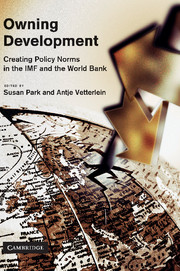Book contents
- Frontmatter
- Contents
- List of figures
- List of tables
- List of contributors
- Preface and acknowledgements
- List of acronyms and abbreviations
- Part One Introduction
- Part Two Norm emergence
- Part Three Norm stabilization
- Part Four Norm subsiding
- 8 The IMF and capital account liberalization: a case of failed norm institutionalization
- 9 The World Bank's global safeguard policy norm?
- 10 The new public management policy norm on the ground: a comparative analysis of the World Bank's experience in Chile and Argentina
- Part Five Conclusion
- Bibliography
- Index
9 - The World Bank's global safeguard policy norm?
Published online by Cambridge University Press: 02 December 2010
- Frontmatter
- Contents
- List of figures
- List of tables
- List of contributors
- Preface and acknowledgements
- List of acronyms and abbreviations
- Part One Introduction
- Part Two Norm emergence
- Part Three Norm stabilization
- Part Four Norm subsiding
- 8 The IMF and capital account liberalization: a case of failed norm institutionalization
- 9 The World Bank's global safeguard policy norm?
- 10 The new public management policy norm on the ground: a comparative analysis of the World Bank's experience in Chile and Argentina
- Part Five Conclusion
- Bibliography
- Index
Summary
Bank management has identified ten key policies that are critical to ensuring that potentially adverse environmental and social consequences are identified, minimized, and mitigated. These ten are known as the ‘Safeguard Policies’ …
(World Bank 2008c)The dialectic between social science knowledge, practical experience, and policy guidelines shows how policy formulation must be approached as a set of evolving norms and not simply as diktats from above.
(Cernea 1993)Introduction
The World Bank established a set of stringent environmental policies for international development lending after environmentalists challenged its environmental impact in the 1980s (Gutner 2002; Park 2005b; Rich 1994; Wade 1997). Collectively these policies and the ideas underpinning them constitute a global safeguard policy norm that conveys legitimized, institutionalized practices for international development lenders. This chapter traces the arc of the Bank's safeguard policy norm through three stages: from its emergence in the 1980s, through to its stabilization in the 1990s, to possible decline in the 2000s. First, the chapter examines how and why the World Bank established the safeguard policy norm through internal innovation, policy sharing and, catalytically, from environmental non-governmental organizations' (NGOs) and industrialized member states' pressure. Second, the chapter details how the policy norm stabilized in the 1990s even as each individual policy was modified as a result of environmentalist, industry and member state engagement. Third, the decline of the safeguard policy norm is posited as a result of the Bank's 2005 Middle Income Strategy and shift towards a Country Systems Approach (CSA).
- Type
- Chapter
- Information
- Owning DevelopmentCreating Policy Norms in the IMF and the World Bank, pp. 181 - 203Publisher: Cambridge University PressPrint publication year: 2010
- 10
- Cited by

